Product management and technical product management are both important roles in the development and success of a product.
Product management is the process of overseeing the development of a product from start to finish. This includes defining the product's strategy and roadmap, conducting market research, and working with cross-functional teams (such as engineering, design, and marketing) to bring the product to market. Product managers are responsible for the overall success of a product and ensuring that it meets the needs of its target market.
Technical product management is a specialized role within product management that focuses on the technical aspects of product development. Technical product managers have a deep understanding of technology and work closely with engineers to ensure that a product is technically sound and feasible. They are responsible for technical roadmaps, feature definitions, and ensuring that the product meets technical requirements.
In short, product management is focused on the overall success of the product, while technical product management is focused on the technical feasibility and execution of the product. Both roles are important for ensuring the success of a product.
PRODUCT MANAGEMENT
Project management is also the intersection of business, user experience, and technology.
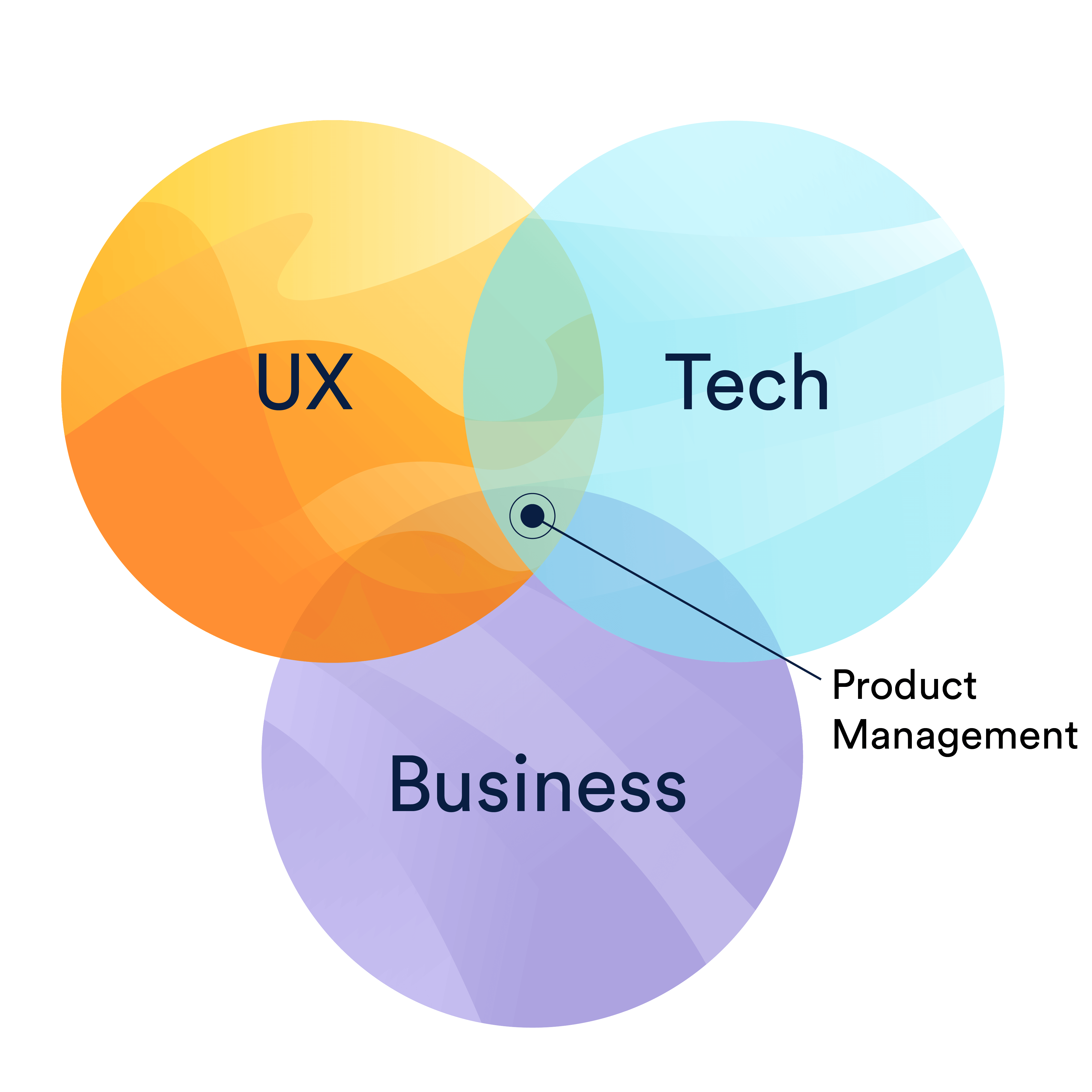
Business — Product management helps teams achieve their business objectives by bridging the communication gap between dev, design, the customer, and the business.
UX — Product management focuses on the user experience, and represents the customer inside the organization. Great UX is how this focus manifests itself.
Technology — Product management happens, day to day, in the engineering department. A thorough understanding of computer science is paramount.
Three additional skills that every project manager needs are storytelling, marketing, and empathy.
Storytelling
Product leaders should be as inspirational as they are tactical, and storytelling is their tool of choice. Through customer interviews and market research, product managers learn more about the customer than even the salespeople. They then use their storytelling skills to share that perspective with the rest of the company.
Marketing
Product Management’s customer focus also informs marketing efforts. Instead of sticking to the brand and using established techniques, product management teams (often including Product Marketing Managers) integrate the language of their customers into the messaging of their product. Furthermore, knowledge of the competitive landscape and the ability to stand out and differentiate pays dividends in the long run. Understanding basic marketing and positioning concepts will help product managers ship products that people can find and relate to.
Empathy
Finally, product management is about empathy — empathy for the developers and how they work, empathy for the customer and their pain points, and even empathy for upper management, who juggle aggressive goals and impossible schedules. This skill in empathy, one developed through immersion within and intimate understanding of each group and stakeholder, separates the product teams that can rally the organization around common goals from those who are incapable of doing so.
Product management roles: The product manager and beyond
In some cases, product management for one product, or a family of products, is handled by a single product manager. This individual must represent a deep proficiency in at least one of the areas that touch product management, and a passion for or fluency in the others. This most often manifests itself in one of two cases: an experienced business marketer with a passion for outstanding user experience and can speak fluent tech lingo or a technical development leader who understands the product so well that they can begin to drive its creation.
Chief Product Officer (CPO) - Leads the product function at an organizational level. Ensures each product is looked after by skilled PMs and their teams.
Product Owner - Takes a more active role in the development of the product by managing the engineering team’s backlog and their communication with other stakeholders.
Product Marketing Manager (PMM) - Improves the product team's ability to reach customers and learn from them through product-tailored marketing campaigns and the insights they provide.
User Experience (UX) Researcher - UX is one of a PM’s core responsibilities, but a dedicated UX researcher, who studies user behavior and makes usability recommendations, is a great addition to any product team.
Technical Product Management(TPM)
Technical Product Management includes a combination of the most sought-after skills in one single position.
TPMs often build products for product people, which requires acute knowledge of both customer and business needs. They know how to collect and deploy data, cracking the engineer’s process and becoming Problem- solving machines.
A technical product manager is a product manager with technical understanding as they will work closely with the engineering team (mostly developers). While they have technical expertise, they don’t perform technical tasks but they focus more on the product management side.
Roles/Responsibilities of TPMs
What are the tasks of a technical product manager?
Defining goals, creating release plans and handling distribution of tasks.
Ensuring technical specification, technical construction, testing, final implementation, and quality assurance.
Mediate as an internal contact person, hold meetings and stay in constant contact with programmers and product designers.
Advise the customers, include feedback and keep them up to date.
Customer acquisition and marketing of IT products
Monitoring of the product life cycle
Evaluation and implementation of product optimizations
Planning and implementation of marketing and communication measures
Uncover and understand customer needs and translate them into requirements.
Ability to work well with internal teams, including developers, engineers, architects, quality assurance, and operations. Ensure requirements are fully understood and that implementation plans match expectations.
Understand, research, and follow technology trends in the industry and in general. Able to assess emerging products and companies to measure their potential value or threat to the company and its products, as well as make recommendations on which new technologies to invest in or leverage.
Follow competitors and conduct capability analysis regularly.
Provide internal and customer training on how to use the product.
Answer incoming questions about the product and its capabilities.
Assess and address technical risks.
Understand and analyze data pipelines, algorithms, and automated systems.
Serve as a product evangelist and subject matter expert to the technical/developer community.
Coordinate beta tests.
Use database queries to analyze performance indicators, evaluate experiments, etc.
Define success criteria for testing and product acceptance.
Facilitate the creation and maintenance of proper product documentation.
Roadmaps for product management
A product roadmap is a high-level, strategic document that maps out the general stages of a product’s development. The main purpose of a product roadmap is to tie a product’s vision in with a company’s business objectives.
A product roadmap is created as a result of strategic planning. It documents both the executive strategy and overall goals of a product. A strategic product roadmap typically includes the following key points:
Product vision — what you want your product to become in the future.
Strategy — an execution plan detailing what your company is going to do to meet the vision.
Goal — a time-bound objective that can be measured by a specific metric.
Initiative — broad themes that unite features that must be implemented to achieve a goal.
Feature — an actual piece of a product that’s either part of functionality or a third-party application.
Time-frames — dates or periods for a certain goal or feature to be finished. As a rule, a product roadmap suggests only an approximation.
Status markers — used to track the progress of work.
Metrics — assistance in the measurement of data-driven goals.
Depending on the product you are developing and the methodologies you are practicing, the number of teams involved in road mapping may vary. Most often, you would have your engineering team, UX, sales, marketing, support team, operational team, designers, and testing team. Those are the people that will work on the actual product.
Any product roadmap must be clear and simple to understand. This helps a product manager guide all the teams throughout the development process, keeping them aligned with customer needs and business objectives. So, a product roadmap is useful and applicable when it meets the following requirements:
Conveys the strategy of the product development
Shows the vision of the product
Evolves and changes with the product and market requirements
Prioritizes high-level units of development
Acts as a communication tool between all people involved
Sets long-term timeframes
Indicates exact goals and ties them to the business objectives
Sometimes, a product manager builds multiple roadmaps of different types to present the information to internal and external stakeholders.
Types and Examples of Roadmaps
Product roadmaps will differ from project to project, because they may be tailored to convey different types of data or follow a different logic.
Strategy & Market Roadmap — deals mainly with high-level details and market state.
Visionary Roadmap — outlines the vision of a product instead.
Technology Roadmap — a complete opposite of the previous two, a low-level technical roadmap for the production team.
Technology Across Product Roadmap — the mix between actual technologies/features planned for product/products.
Platform Roadmap — aimed at multiplatform digital products.
Internal & External Product Roadmap — tied to different types of audience.
The now-next-later roadmap describes the tasks/sprints/features in a prioritized way. Basically, it’s a simplified version of a product backlog that categorizes items of information horizontally and vertically. It shows what will be released now, what’s prepared next, and what will be released later. The purpose of this roadmap is to show priorities in the simplest way possible.

A Goal-Oriented roadmap helps to keep all information grouped and clearly explained. Goals determine a reason for every feature to exist. A goal can be stated in simple words such as “Increase user engagement” or “Make registration process faster.” By organizing the information around the goals, you will keep your roadmap high-level and make your strategy and vision easy to understand.

A Theme-based roadmap is similar to the goal-oriented one. The goal and theme concepts are close as they both answer “why” questions. The only difference is that themes consist of several goals at once.
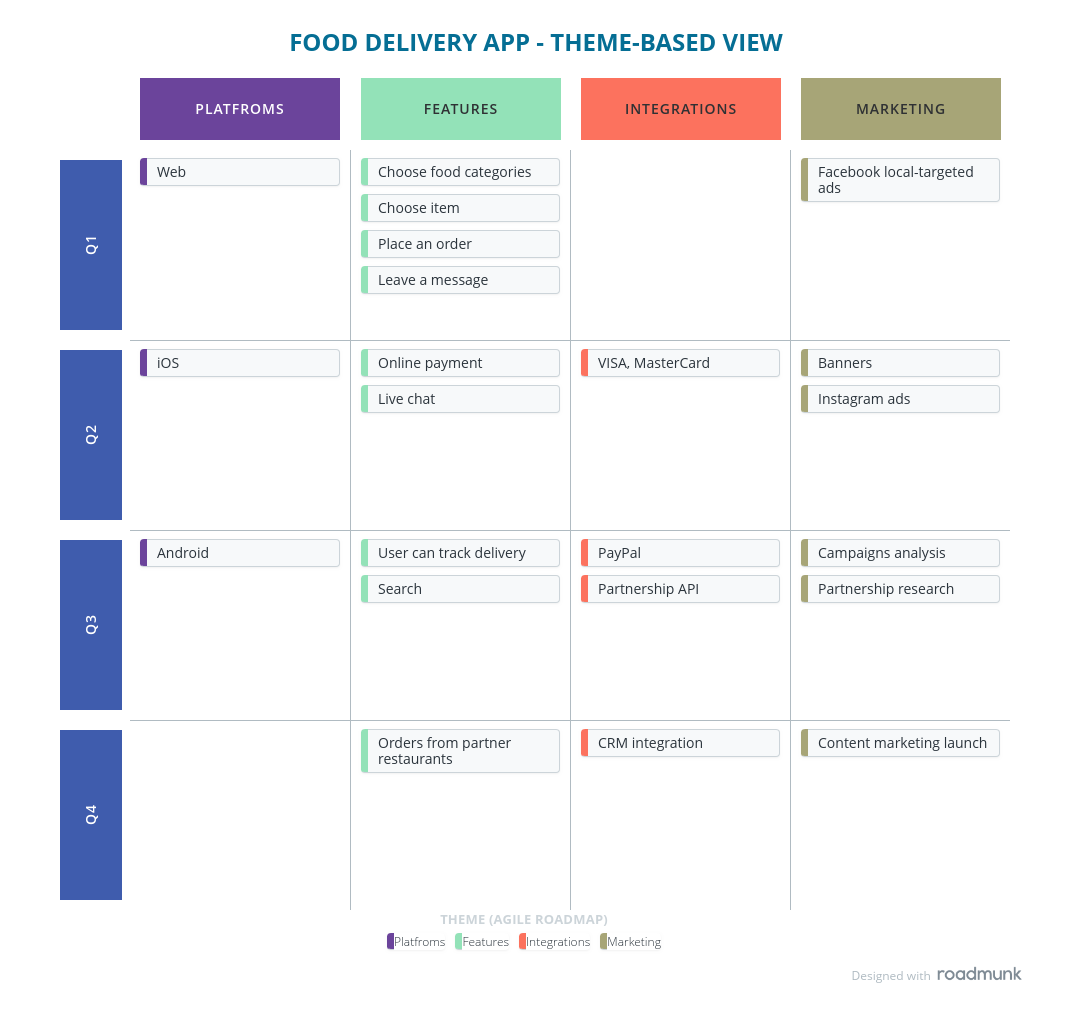
A Feature-based roadmap entails using a feature as a central point of your roadmap making it very detailed. The drawbacks are:
A feature is not a stable unit considering the changing market. Technological innovations and customer needs to cause your feature set to change quite often.
A feature-based format doesn’t provide high-level details, which blurs a general vision of the product, making your roadmap practically more difficult to maintain and harder to understand.
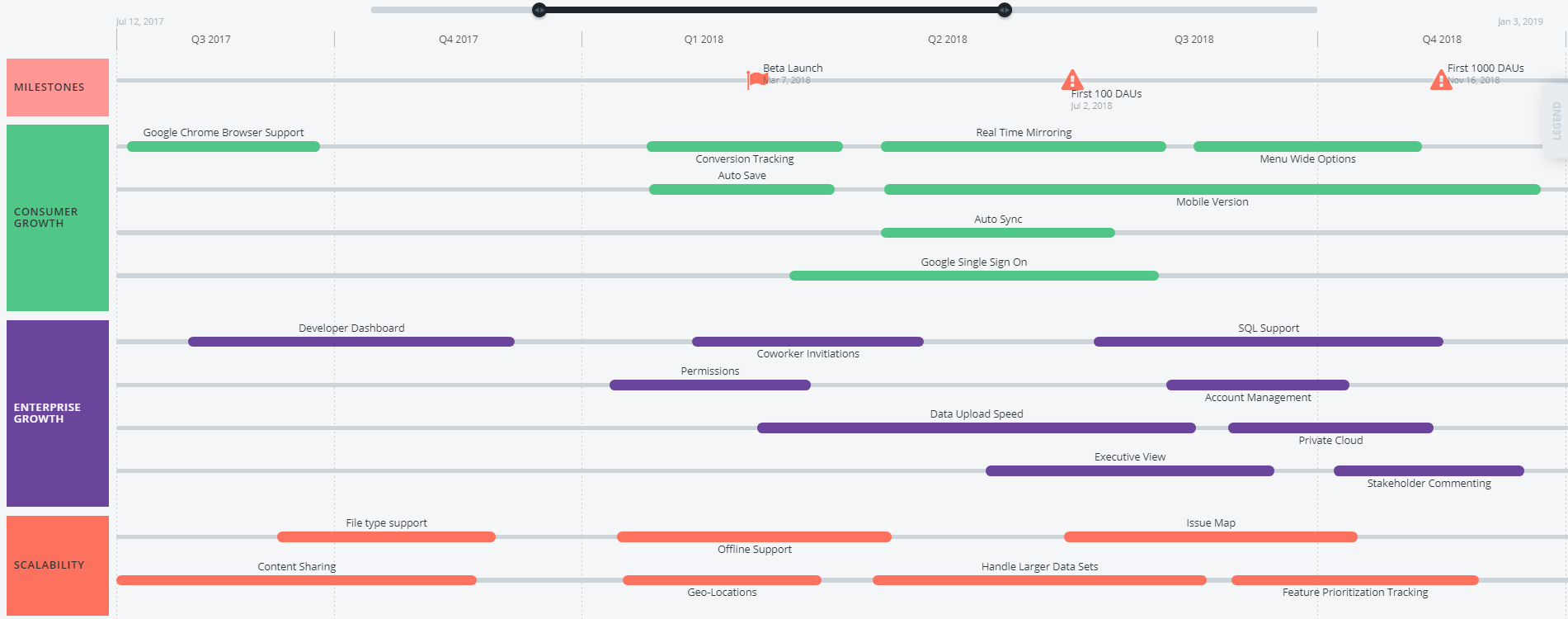
A strategy roadmap is a general-purpose roadmap. It can include any type of information and be tailored to both internal and external audiences. It is a high-level outline of general product information tied to a specific aspect depending on the purpose.

Technology roadmaps or IT roadmaps are more low-level documents usually created to support the main strategic roadmap. They are used for the internal teams to formulate tech requirements. Technology roadmaps determine the use of certain technology and help to allocate resources they depend on.
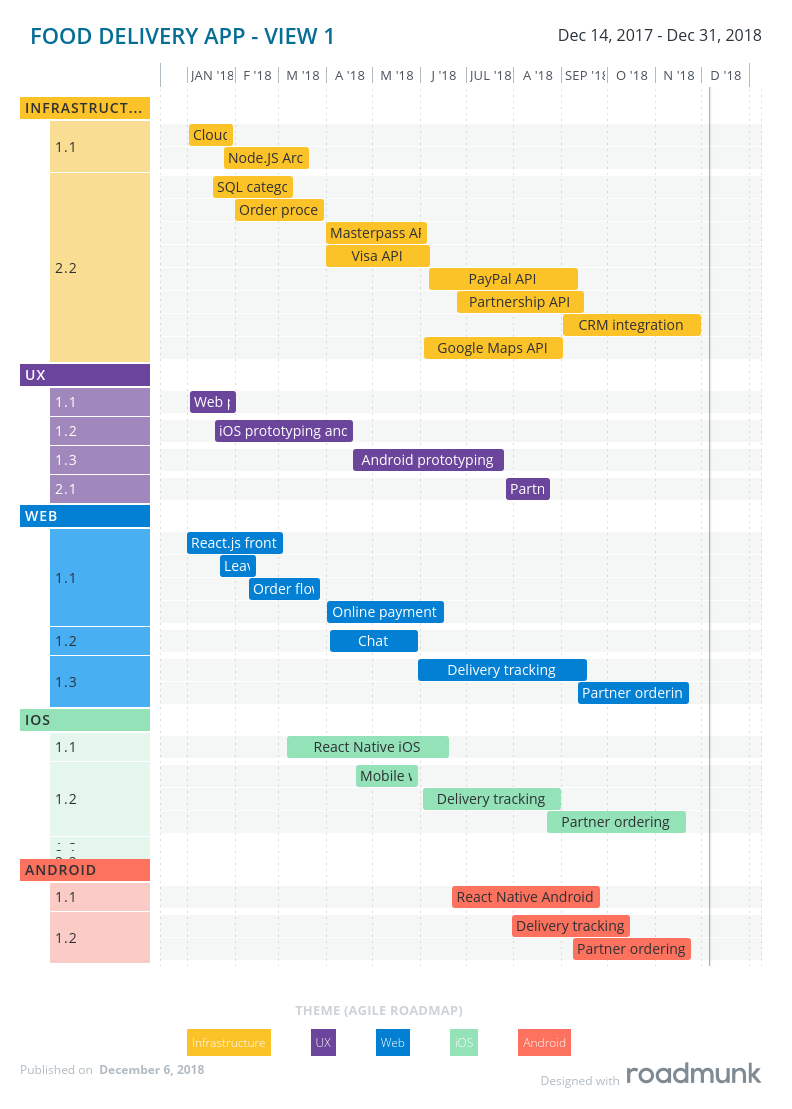
Manufacturing roadmaps are created for the actual manufacturing of a physical product. The name is self-explanatory, as manufacturing roadmaps help to control manufacturing and set actual dates for a particular release.
A portfolio roadmap is used to communicate the strategy of a product line between executives and product managers. In companies with multiple products, it’s essential to see how each product evolves and how different products relate to each other to accomplish high-level business objectives.
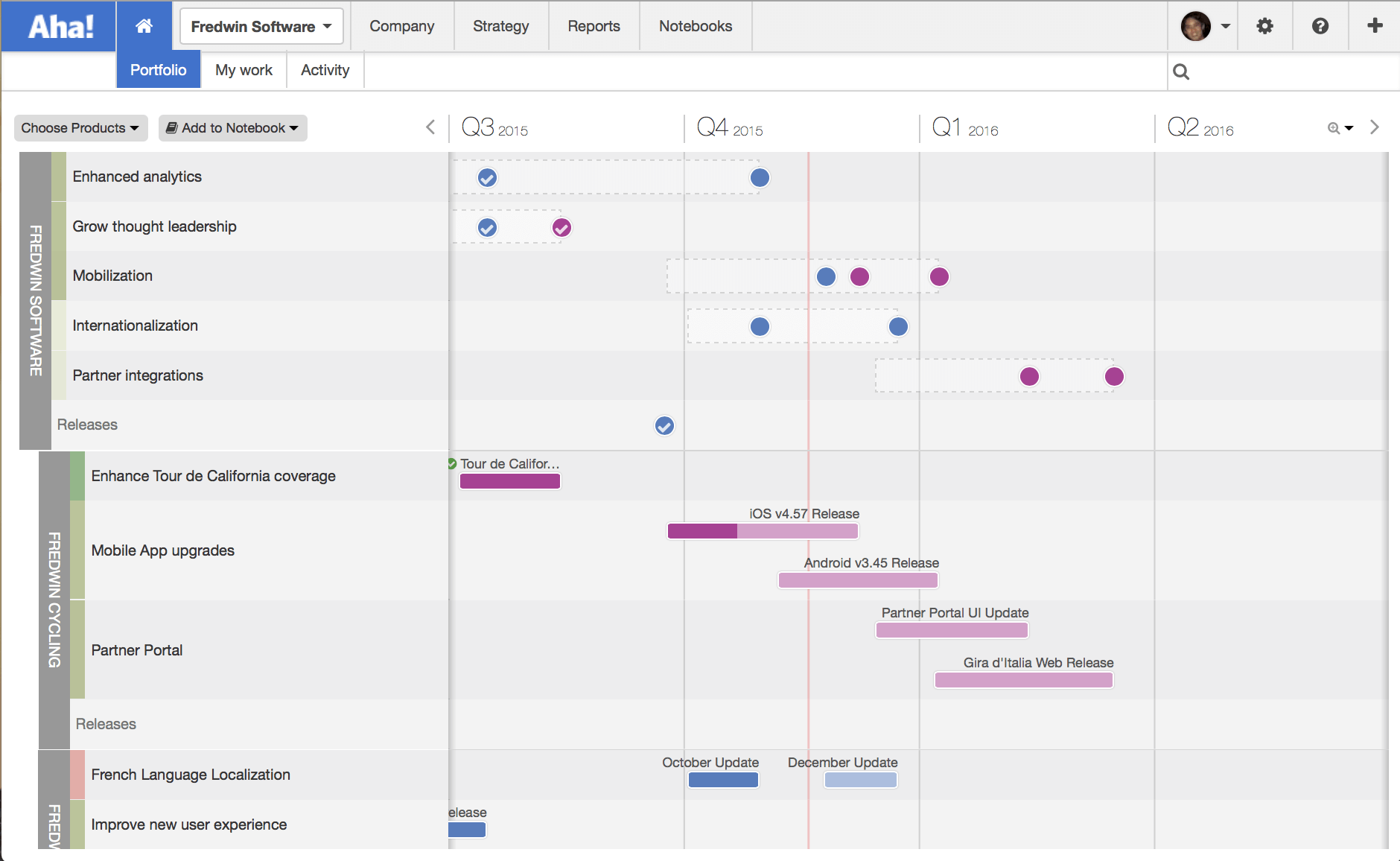
A release roadmap is an example of an external roadmap presented to customers. This type of roadmap represents major releases of app functionality for public consumption, so it doesn’t need many tech or practical details.

A market roadmap is a document that may be used if the product launch is planned across multiple markets. It’s mostly developed to enable the marketing department and internal stakeholders to plan a marketing strategy for single or multiple products. Market roadmaps are, perhaps, the most dynamic ones, as they have to capture the rapid changes in the market. Competitor or technological progress may cause significant shifts requiring strategy adjustment. At the same time, they include three or four items, as companies rarely distribute their products to a large number of markets.
Differences between PM and TPM
Product Manager | Technical Product Manager | |
Research | Studies the competitive landscape from a strategic business and go-to-market perspective | Evaluates competitors and the market for capability-oriented and emerging development and technology trends |
Background | Business, Marketing, UX, Software development, engineering | Technical background, software development, engineering |
Core Skills | Market research knowledge of UX best practices understanding of the web development process (not necessarily coding)Writing specs and requirements critical thinking and analytical skills | Computer science, software development, or engineering knowledge understanding of software development methodologiesProduct roadmap development understanding of APIs |
Big Picture Focus | The “Why” of a product. Often customer-facing and involved in setting the overall product strategy | The “How” of a product. More focused on how the product works and tends to be more capabilities focused |
Teams They Work Closely With | Collaborates with many non-technical teams, including UX, sales, marketing, and support — and works with outside partners and other third-parties | Works closely with technical internal teams, including engineering and development, to write user stories and requirements |
Conclusion
Technical product managers can be a tremendous asset to the product management team. They bring a different perspective than their more marketing and business-oriented peers that can be both a reality check as well as unlocking new possibilities by leveraging new technological advances.
They can also be an incredibly helpful bridge to the technical teams that may not always respect the decisions coming out of product management due to their lack of deep technical understanding. Being able to engage with engineering on a level playing field can yield better, faster, and more innovative outcomes for solving business problems and addressing customer needs.
Ideally, a product management team has enough resources to include technical product managers as partners for the business-facing product managers, joining forces to take a holistic view of the challenges and potential solutions to make well-informed, fully-baked recommendations. However, relying solely on these individuals may neglect some key areas of product management, ignoring key business, and go-to-market issues.
